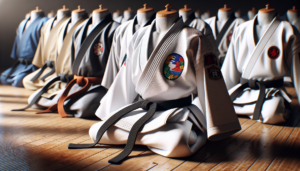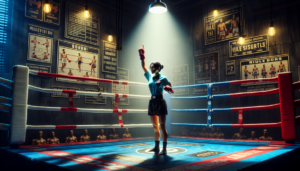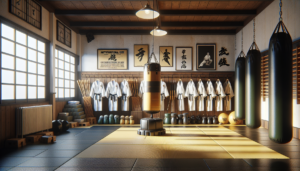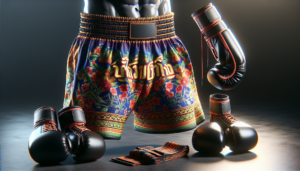Introduction to Goku’s Fighting Stance
Goku, the iconic protagonist of the Dragon Ball series, is renowned for his exceptional martial arts skills and unique fighting style. His fighting stance is a defining characteristic that embodies his combat readiness and visual strength. The stance is deeply rooted in various martial arts techniques, showcasing Goku’s mastery of the art of fighting.
Goku’s fighting stance is a perfect balance of offense and defense. He stands with his feet shoulder-width apart, knees slightly bent, and arms raised in a guard position. This stance allows him to react quickly to any incoming attacks while also being ready to launch his own powerful strikes. The slight bend in his knees provides stability and the ability to swiftly change directions or dodge attacks.
The Origins of Goku’s Fighting Stance
Goku’s fighting stance can be traced back to his early training under Master Roshi, where he learned the fundamentals of the Kame style. This style emphasizes fluid movements, strategic strikes, and the ability to adapt to various combat situations. Goku’s stance incorporates elements of the Kame style, such as the raised guard and the balanced posture, which allow him to effectively defend and counterattack.
Throughout his journey in the Dragon Ball series, Goku encounters numerous martial arts masters and incorporates their teachings into his own fighting style. He learns from the likes of Korin, Kami, and King Kai, each contributing to the development of his unique stance. By integrating these various techniques, Goku creates a fighting style that is both versatile and powerful.
Significance of Combat Readiness and Visual Strength
Goku’s fighting stance is not only practical but also carries symbolic significance. The stance represents his unwavering determination and readiness to face any challenge head-on. It showcases his visual strength, intimidating opponents and inspiring allies alike. The mere sight of Goku in his fighting stance is enough to strike fear into the hearts of his enemies and instill confidence in his friends.
The stance also demonstrates Goku’s mental preparedness for battle. It reflects his focus, concentration, and strategic thinking. When Goku assumes his fighting stance, he enters a state of heightened awareness, analyzing his opponent’s movements and anticipating their next move. This mental fortitude, combined with his physical prowess, makes Goku an exceptionally formidable fighter.
Evolution of Goku’s Fighting Style in Dragon Ball Super
In Dragon Ball Super, Goku’s fighting style undergoes significant evolution as he faces new challenges and encounters powerful adversaries. The series introduces gods, angels, and formidable mortals who push Goku to his limits, forcing him to adapt and innovate his fighting techniques.
One notable development in Goku’s fighting style is his mastery of the Super Saiyan God and Super Saiyan Blue transformations. These transformations grant him immense power and speed, allowing him to go toe-to-toe with gods like Beerus and Zamasu. Goku’s fighting stance evolves to accommodate these new powers, incorporating more fluid and dynamic movements.
Key Battles and Adaptations
Throughout Dragon Ball Super, Goku engages in numerous battles that showcase the evolution of his fighting style. In his fights against Frieza, Goku demonstrates his ability to adapt to his opponent’s techniques, countering with his own innovative strategies. Against Jiren in the Tournament of Power, Goku pushes himself to new heights, unlocking the Ultra Instinct transformation, which grants him unparalleled reflexes and combat instincts.
Goku’s battles against Broly, the legendary Super Saiyan, also highlight his adaptability. Faced with Broly’s raw power and relentless assaults, Goku adjusts his fighting stance to prioritize defense and counterattacks. He employs techniques like the Kame Style’s after-image and the Instant Transmission to outmaneuver Broly and find openings for decisive strikes.
Training with Whis: Importance of Guard in Combat
Goku’s training with Whis, the angel attendant of Beerus, further refines his fighting stance and emphasizes the importance of guard in combat. Whis teaches Goku the significance of maintaining a strong defense while simultaneously being ready to attack. This training enhances Goku’s ability to anticipate and react to his opponent’s moves, making his fighting stance even more effective.
Under Whis’s guidance, Goku learns to keep his guard up even when launching offensive strikes. This allows him to quickly transition from attack to defense, minimizing openings for his opponents to exploit. The importance of guard becomes evident in Goku’s battles, where his enhanced defensive capabilities often prove to be the deciding factor in his victories.
Cultural Significance of Goku’s Fighting Style
Goku’s fighting style and stance have become iconic in the world of anime and have had a profound impact on popular culture. His unwavering determination, resilience, and the visual representation of his strength through his stance have resonated with fans worldwide.
Symbolism in Anime Culture
In anime culture, Goku’s fighting stance has become a symbol of the hero’s journey and the pursuit of personal growth. It represents the idea that with dedication, training, and an indomitable spirit, one can overcome any obstacle. Goku’s stance embodies the core values of martial arts, such as discipline, respect, and the constant striving for self-improvement.
The visual impact of Goku’s fighting stance has also influenced the way martial arts are portrayed in other anime series. Many characters in various anime adopt similar stances, paying homage to Goku’s iconic pose. The stance has become a shorthand for a character’s fighting prowess and heroic nature.
Goku’s Determination and Resilience
Goku’s fighting stance is not just a physical posture; it is a manifestation of his unbreakable spirit. Throughout the Dragon Ball series, Goku faces seemingly insurmountable challenges, but he never backs down. His stance reflects his determination to fight until the very end, no matter how powerful his opponents may be.
Goku’s resilience in the face of adversity has become a source of inspiration for fans. His fighting stance serves as a reminder that even in the darkest of times, one must stand tall and face their challenges head-on. Goku’s unwavering resolve and his ability to rise above his limitations have made him a beloved character and a symbol of perseverance.
Emotional Strategies in Goku’s Fights
In addition to his physical techniques, Goku employs emotional strategies in his fights, using his fighting stance as a means of conveying his state of mind. His stance reflects his emotional state, whether it’s the calm focus before a battle or the explosive anger when pushed to his limits.
Role of Emotions in Combat
Goku’s emotions play a crucial role in his fighting style. When he is calm and focused, his stance is relaxed yet alert, allowing him to analyze his opponent’s movements and plan his attacks. However, when Goku is enraged or emotionally charged, his stance becomes more aggressive, with his energy surging around him in a visible aura.
This emotional intensity fuels Goku’s power, enabling him to push beyond his normal limits. His fighting stance channels this emotional energy, directing it towards his attacks and defenses. The connection between Goku’s emotions and his fighting stance adds depth to his character and showcases the complex dynamics of combat.
Goku vs Vegeta: A Comparative Analysis
A notable comparison can be drawn between Goku’s fighting stance and that of his rival, Vegeta. While both characters are formidable fighters, their stances reflect their distinct personalities and approaches to combat.
Vegeta’s fighting stance is often more rigid and aggressive, reflecting his pride and desire for dominance. He tends to rely on raw power and overwhelming force, whereas Goku’s stance emphasizes balance and adaptability. Goku’s stance allows him to be more fluid in his movements, adjusting to his opponent’s techniques and finding openings for counterattacks.
The contrast between Goku and Vegeta’s fighting stances highlights their character development throughout the series. As they both grow and evolve, their stances also undergo subtle changes, reflecting their personal journeys and the lessons they learn from each other.
Conclusion
Goku’s fighting stance is an integral part of his character, representing his martial arts prowess, unbreakable spirit, and cultural significance. It embodies the core principles of Dragon Ball, such as the pursuit of strength, the importance of training, and the power of determination.
From its origins in the early days of Goku’s training to its evolution in Dragon Ball Super, the fighting stance has been a constant companion in Goku’s battles. It reflects his growth as a fighter and as a person, adapting to new challenges and incorporating the teachings of his mentors.
Goku’s fighting stance has transcended the boundaries of the anime and manga, becoming an iconic symbol in popular culture. It represents the heroic ideal, the unbreakable spirit, and the belief that with dedication and perseverance, one can overcome any obstacle.
As fans continue to follow Goku’s adventures in the Dragon Ball series, his fighting stance will remain a defining characteristic, a visual embodiment of his strength, determination, and the enduring legacy of a true martial arts hero.
#ED#





